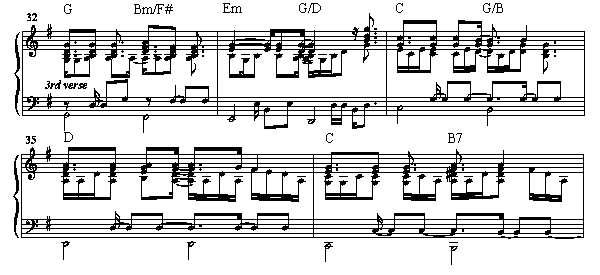Recover Your Soul is one of a number of the
beautiful ballads off The Big Picture. For some reason this
album didn't click with people. I'm not sure I understand
why. It could be the syrupy arrangements. Personally I think
a lot of the songs are well crafted and this song in particular
is an uplifting look at recovering from a broken relationship.
As with many of Elton's songs, I believe the solo piano arrangement
helps to bring out the inherent beauty that might get lost
in the orchestral arrangements. This version is taken from
Elton’s
1999 Solo Tour, Roanoke Virginia, recorded on 02/19/1999.
I've
included
an mp3 for
your reference.
Basic Piano Style
This is an excellent tune for the intermediate pianist.
Like many of the songs on Elton’s solo tour, Elton’s
voicing and technique are superb. I've discussed these elements
in other articles. His basic style includes:
- The right hand is always positioned over a 4-note chord.
- Rhythms are based on a straight 16th note pulse.
- Chords or partial chords are played on the downbeat
of 1 and 3, the upbeat before 2 and 4, and/or the upbeat
after 2 and
4.
- Single notes from the chord played on most of the other
16-note intervals.
- Left hand work is stroked and phrased rather than
just struck in a purely rhythmic phasion; the left hand
sometimes supports the right hand work and other times
interplays with the right hand.
- The chords frequently include some kind of movement
or riff including the use of different inversions, suspensions
or added notes.
- The left hand primarily plays on the octave or occasionally
on the root and 5th of the chord.
The left hand work in this example is reminiscent of Tiny
Dancer in that Elton creates lines with the octave and 5th,
giving some counterpoint to
the right hand. It’s easy to treat the left hand as
if it were merely a rhythmic element rather than a harmonic
element. Elton voices it very carefully so that it
is an integral part of his playing style. The riff over the
G chord is one of my all time favorites.

Harmony
Recover is in the key of G and uses a descending bassline
approach for the harmony to the first half of the verse.
Across a 4-bar structure we have
|| G – Bm/F# - | Em – G/D – |
C – G/B – | D – D – ||
If you just look at the 1st chord in each bar - treating
the 2nd chord as a passing chord - this harmony is essentially
the time honored I – vi – IV – V
chord progression first introduced in classical music and
the basis
of much of
popular
music. In the 2nd half of the verse, Elton covers the same
harmonic ground in a slightly different way.
|| C – B7 – | Em – Em – |
C – G/B – | D – D – ||
You can see that the 1st chord in each bar is the same,
but the 2nd chord varies. The B7 chord is called a secondary
dominant. In the key of G, the Bm chord is the diatonic
chord of the chord that occurs naturally. The B7 chord is
the natural dominant chord
in
the key of Em, and by playing it, you get a slightly stronger
sense that a temporary key shift has occured.
The chorus really takes off on some interesting twists and
turns. :
| C – G – | Am – Em – |
F – G – | D – D – |
| Am – B7 – | Em – C – | D G/F
C/G D |
This example shows the descending bassline harmonic approach
to the verse. Elton's playing style is on perfect display
here: his basic approach to rhythm, the use of right hand
riffs to provide movement and harmonic interest, and a carefully
articulated left hand that's interwoven with the whole thing.

All in all, it’s a great example of Elton’s
work. Hope you enjoy it!
|

